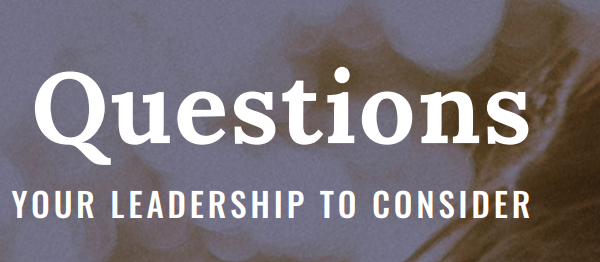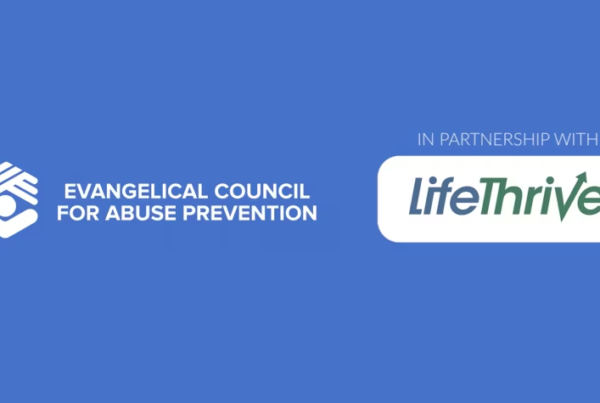This article originally appeared on the Focused Pastor website here.
Seventeen years ago, I (Courtney) enrolled as a seminary student at a Southern Baptist seminary. Like many young students, I was eager to get started. I wanted to serve the church, care for women, and teach the Bible. Call it ignorance, youth, or a combination of both, abuse prevention and care for survivors was not even on my radar. While abuse was in my family’s history, it was a distant memory and not part of my immediate story. I didn’t even know how to prepare for it in my first ministry context.
I’ve been in some kind of vocational ministry for nearly 20 years, and I wish I could say that the ignorance held. I’ve sat with survivors processing recently remembered childhood trauma. I’ve been in law enforcement offices. I’ve heard horrific stories but also seen incredible faith. I know I’m a stronger Christian because I’ve been privileged to know people who had the courage to speak. And while it’s a hard road, I now believe that every leader needs more training than they realize when they care for God’s people.
It took me longer to graduate from seminary than most, so when I re-entered seminary, I needed to take Ministry Safe training to register for classes. This was a newly adopted recommendation by Southern Baptists to prepare ministry leaders for the reality of the crisis of sexual abuse in our denomination. By this time, I had children.
The training worked.
A few years later, I found myself leading in a church where a sex abuse scandal came to light. The tools I received in the training gave me categories for response, questions to ask leaders above me, and an action plan for caring for the survivors. But even those tools weren’t enough.
I, Jeff, helped launch ECAP (Evangelical Council for Abuse Prevention), an organization I now lead. We were created in 2019 to provide awareness, accreditation, and resources to help Christian Organizations establish a set of standards that help protect children. We (Courtney and Jeff) both have seen firsthand what happens in a church or institution when these steps aren’t taken.
Let’s look at six steps your ministry can take starting today to protect the vulnerable in our churches from abuse.
Establish Good and Godly Governance Practices
There is a reason why we put this first. In almost every instance of abuse allegations and response, things go south when leadership is not aligned—or worse, there are no leadership structures in place. It’s hard to protect the sheep if the shepherd isn’t on board. You can have great policies in place, but when abuse allegations arise or you need to implement your policies, a failure of leadership or clarity on how leadership functions muddies the waters.
Polity matters when you’re protecting the sheep. In 1 Timothy 3, Paul instructs his mentee, Timothy, on what to look for when identifying shepherds. We place a premium on the preaching ability of our pastors, or we look for a dynamic leader to nominate to the elder board. Preaching and leadership capacity are important, but Paul spends more time on character than anything else. And he assumes there will be more than one elder or leader. A healthy church begins at the top, and abuse prevention begins there, too.
Spend time shoring up how you identify elders. Make the qualifications in 1 Timothy 3 your church’s qualifications for leaders. Make character a premium when you’re calling your pastor, but also ensure that your pastor isn’t on an island. Don’t give too much power to one leader, even if he is the lead pastor. Protection and prevention starts with leadership.
Appoint a Child Safety Coordinator and Team
After establishing healthy church governance, your next step should be hiring or recruiting a Child Safety Coordinator. This usually happens after an allegation arises, but it leaves your church behind in care and safety. Scrambling afterward feels reactionary and won’t give you enough time to vet, interview, and train these people. This can be someone in your church who is a resident expert in counseling, childcare, or advocacy. It can also be someone in your church actively serving in ministry to children. The person should have a vested interest in protecting children. If your church is small, or your budget doesn’t allow for multiple staff positions, it can also be a volunteer role. More important than a paycheck is this position’s access to leadership, ability to coordinate, and overall care of the vulnerable in the church.
Many instances of abuse involve women or female children. Research shows that women are more likely to feel comfortable disclosing to a woman. This is why appointing a woman as Child Safety Coordinator would be wise. We recognize that not every church will be able to do this, but in general, it is a good practice to aspire to. Even if she is not the Child Safety Coordinator, it’s a real must to have a woman on the child safety team. When you have a woman on your child safety team, you signal to survivors that you want to provide a safe place for them to find help and care. Having a woman in the room who has access to all child safety policies, as well as access to elders and pastors, ensures all voices are heard.
The Child Safety Coordinator and team should conduct a full policy review to establish best practices, training plans, and policies for prevention and care. Included in this policy review, the team should establish a plan for off-campus activities, retreats, camps, VBS, athletic programs, and groups that use your facilities. Problems arise when the guard is down, and the church is still responsible for those under her care, even if it’s not a Sunday morning or Wednesday night.
For a full list of ECAP standards, please visit our website. We include a standards checklist for your church, definitions, resources, and the pathway to accreditation if your church is interested.
Once your policies have been reviewed and established, the Child Safety Coordinator and team are ready to implement them across all ministries.
Screen All Employees and Volunteers Who Have Access to Children, Youth, and Vulnerable adults
I (Courtney) am a public school teacher. The amount of screening, training, and refreshers we undergo to teach a classroom full of kids makes our church screening and training look rudimentary and simple in comparison. This shouldn’t be the case. Christians should excel at protecting the most vulnerable. Our theology of sin leads us to believe that anything is possible, yet we often assume the best without validating information.
The Child Safety Coordinator should establish a screening process for all staff and volunteers in your ministries. This includes an interview process with each person, two to three references, and initial background checks. Most churches use background checks, which is a start. But your church needs more to ensure children are protected.
Train Your Church on Abuse Prevention Basics
This includes definitions, impact, and the problem of abuse in our society as a whole and in our ministries, identification of indicators of abuse, common grooming behaviors, mandatory reporting, an overview of ministry prevention policies, code of conduct, and response protocols.
Along with screening, your church needs robust training in child safety and protection of the vulnerable. The 2023 Annual Church Profile by Lifeway Research indicated that only 36% of churches provide training in abuse prevention, protection, and reporting. We mentioned Ministry Safe at the beginning of this article, which is a start. But we need more. Bring in law enforcement who are experts in handling abuse. Attorneys can train your volunteers and staff on mandatory reporting laws, and CPS (Child Protective Service) workers and counselors can give you tools for identifying abuse and caring for survivors.
Maintain Ratios of Workers to Minors and Good Visibility in Programs
This is non-negotiable. It is a standard that must be set before parents begin bringing their children to your check-in station. It will be hard to turn them away if you don’t have a policy in place. One church I (Courtney) was part of delayed starting Sunday School for a few weeks until they had these in place. It might make people upset, but we can’t sacrifice safety for a few hurt feelings. It might actually prompt people to volunteer as well.
Have a Response Plan in Place Before a Report or Allegation of Abuse
The worst-case scenario is that abuse happens in our church or is perpetrated by someone from our church.1 But an even worse scenario is that you respond poorly (or illegally) once it occurs. The same Lifeway Research study said that only 16% of churches are equipped to care for those who have been abused. Questions that your leadership needs to answer are:
- Who reports? This is where understanding mandatory reporting law is important.
- Will you double-report? Some states require you to file a police report and a report with the child abuse hotline.
- When you report, who else do you notify? This should be your Child Safety Coordinator. This person then manages the rest of the response plan.
- Who tells the church? How will you do that?
- How do you notify families? Will you have a church meeting? Or will you send a letter?
Who cares for the survivor? After reporting, this is the most important. The Child Safety Coordinator must also have a care team or person to walk alongside the survivor. This is another article, but the path towards justice is long. A church that cares well for the abused walks that road with them.
I (Courtney) never dreamed I would use the tools I received from Ministry Safe when I did the training in seminary. But I’m glad I had it. I (Jeff) never dreamed this would be my work in this time of my life. But I’m glad I’m in it.
Child/Youth protection and abuse prevention are matters of biblical stewardship and Great Commission importance. The temptation to preserve the institution will be high when allegations arise, so you must have a plan before this happens. And stick to it. There is a lot at stake in how we respond and care for survivors and children in our churches. God’s heart for the vulnerable shines through when we prioritize equipping our churches to respond and prevent abuse. If it feels overwhelming at first, take it one step at a time. Even starting with one step today begins the process of developing and fostering a culture of safeguards for the vulnerable in your ministry. But you must start somewhere. Assess what you’re already doing using these six steps—what area needs the most attention? That is where you start.
Don’t be afraid to ask for help and seek the input of organizations and experts in this field. Finally, communicate what you are doing with your leaders, parents, and other stakeholders to give them confidence and peace of mind. Communication is key in protection, prevention, and care. Together, we can foster trust and transparency and be prepared to stand before the Lord and give an account of what has been entrusted to us. Lord, help us.
©2024 Jeff Dalrymple and Courtney Reissig. Used with permission.
- Abuse most often happens outside of the ministry context. Ministries need to be educated on how to identify and respond to abuse outside ministry contexts that are perpetrated by trusted adults or ministry volunteers. Julie Lowe’s book, Safeguards, is a good place to start in becoming educated about identifying abuse in non-ministry contexts. ↩︎





